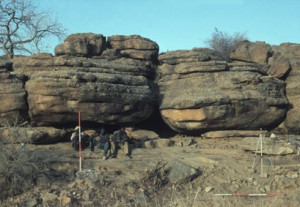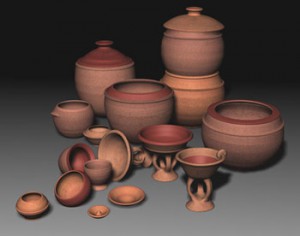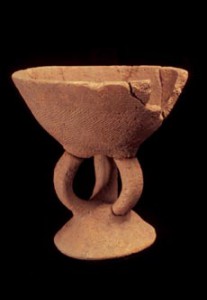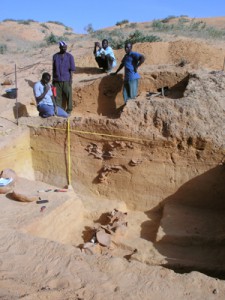The issue
The question of migrations in the face of multiple contingencies, whether human or natural, and the resulting human impact on landscapes is a growing interest among archaeologists, as well as historians, ethnologists and geographers, even politicians and those involved in development aid projects, all of whom are concerned with the topic of migrations and environment, but who often lack references with historical depth.
A better understanding of the origins of modern settlement and relationships between the first and last arrivals in the Dogon Country is also of interest for local populations and authorities, with challenges related to land rights and power dynamics, which should be regarded as revealing of a complex history typical for a refuge zone the consequences of which are still expressed today.
Dutch research in the 1970’s and 1980’s in the escarpment caves near the village of Sanga provided the basis for a preliminary chronocultural sequence in the Dogon Country which was until recently the only reference. This sequence consisted of three stages: a “Toloy” occupation during the 3rd-2nd centuries BC, a “Tellem” occupation from the 11th to 15th centuries AD and a Dogon occupation after the 15th century. This astonishing sequence marked by a gap of more than a thousand years, during which climatic conditions were, however, favorable for occupation and when the first state formations developed in the Niger Bend, deserved reassessment by new excavations and broadening of the scope of the study to include the entire Dogon Country.
Objectives and research methods
The overall objective of our project focuses on the reconstruction of pre-Dogon and Dogon settlement patterns, in relation to climatic and environmental change, and to determine the mechanisms causing migrations, by combining data from several disciplines including archaeology, ethnoarchaeology, ethnohistory and archaeobotany.
A settlement model, based on an actualistic approach of correlations between the characteristics of ceramic production processes and ethnolinguistic units, developed as part of a PhD dissertation for the Niger Bend (Mayor 2005, 2011 ; see list of publications), serves as a reference for the interpretation of the archaeological record and may be refined or challenged as new data are recovered.
Surprising results
Since 1998, we have carried out several archaeological excavations on the plateau in the Ounjougou region and on the Bandiagara Escarpment in the Yawa region, that have allowed considerable advances in understanding of pre-Dogon settlement during a hitherto poorly understood period of history.
The contrasting ceramic assemblages from several sites, including the burials of Dourou-Boro at the top of the escarpment (excavations E. Huysecom; 2nd-9th centuries AD), the domestic material deposit of Songona 2 in a sandy dune at the base of the escarpment (excavations A. Mayor; 5th-11th centuries AD), the ritual rock shelter of Dangandouloun on the plateau (excavations A. Mayor; 7th-12th centuries AD), the Promontoire d’Ounjougou on the border of the Yamé river (excavations A. Downing; 7th-13th centuries AD), and the metallurgical production site of Fiko (excavations S. Perret; 7th -19th centuries AD), indicate a previously unsuspected socioeconomic complexity and diversity in groups during the 1st mill. AD.
Thus, after a break with the Late Neolithic sites abandoned during the 4th century BC, the Dogon Country can be seen as an interface zone between three different ethnolinguistic regions, Mande, Gur and Songhay, whose influences vary by region and period. The abundant production of carefully crafted tripod cups, found far and wide for several centuries along the Niger River in the Yatenga (Burkina Faso), increasing iron production as at Fiko, and prestige goods from long-distance trade, such as grass beads from the Middle East at Dourou-Boro, show significant contacts with the exterior from the middle of the 1st mill. AD.
The 13th century sees the fall of the Ghana Empire and the emergence of the Mali kingdom. Oral traditions recount the departure of the first Dogon groups resistant to Islam from the “Mande” region between Guinea and Mali during this period. After the 15th century, the Songhay Empire expanded it hold over the Niger Bend. Military operations and slave raids led different populations to seek refuge in places difficult to access. Granaries were built on the escarpment to protect the crop harvest and material traditions changes, thereby revealing the arrival of a new populations.
The many surveys of oral tradition and the study of several abandoned villages near the Ounjougou site complex allow us to clarify the issue of Dogon settlement. With respect to material, the ceramic assemblages from abandoned villages are increasingly dominated by pots shaped by hammering on straight cord weaving, the tradition practiced today by the wives of Dogon farmers. Oral histories reveal several phases of settlement by different clans who today claim belonging to Dogon ethnic groups, which led to the foundation of most of the current villages between the 15th and 19th centuries. The local history is complex and consists of frequent village relocations due to climatic and political instability: the discovery of water sources, drying up of rivers, famines and land conflicts, as well as retreats following slave raids by neighboring Peul, Bambara and Mossi groups.
This initial research led to the development of a preliminary settlement scenario for the Dogon Country linked to climatic and environmental change (Mayor et al. 2005; Mayor 2011; see list of publications).





